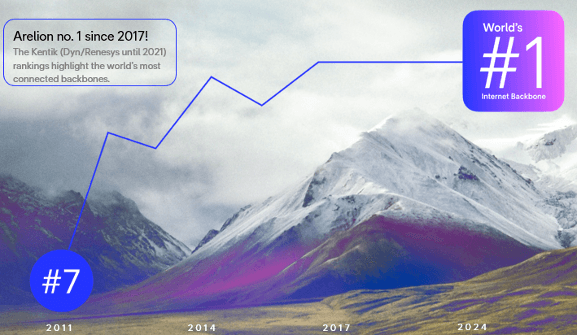Backbone rankings typically assess quality based on a number of relevant criteria, aiming to provide valuable information to users by offering a comprehensive impression of a particular network. Internet ranking is a fairly complex process requiring an assessment of many performance parameters.
To simplifying things somewhat, Internet backbone performance is typically evaluated on various key factors, including speed, coverage, capacity, security, scalability, peering, latency, and cost. Together, these elements contribute to the overall effectiveness and reliability of backbone infrastructure. Ultimately, backbone rankings provide an indication as to how well-connected different Internet backbones are.
Speed – the ability to carry data traffic quickly without interruption. Backbones with faster speeds and greater capacity can handle data traffic more efficiently, reducing congestion.
Capacity – a backbone’s ability to manage big data volumes.
Coverage - geographical presence and reach. A backbone that spans a broader global or national area is generally considered more robust.
Scalability –a backbone’s capacity to efficiently handle increased traffic when necessary. In other words, the infrastructure is designed to be flexible and adaptable, ready for quick adjustments.
Security – fundamental security measures include encryption, DDoS protection, and network monitoring capabilities. A backbone with robust security features would indeed rank higher.
Peering connections –backbones with well-developed peering ecosystems can provide broader coverage and more efficient routing, also contributing to their higher ranking in the Internet hierarchy.
Latency – low latency is directly correlated with higher speed, and as a result, backbones with low latency are often ranked more favourably.
Reliability – often assessed through uptime, which offers a realistic overview of backbone quality and efficiency. A backbone with consistently high uptime is considered more reliable.
Cost-efficiency – Although not directly tied to technical performance, cost matters. Consider pricing structures, value-added services, and overall cost when evaluating backbones.
Development – Continuous development is essential for maintaining a strong foundation. It’s not a matter of choice and involves constantly adapting to new technologies and trends.
Customer Satisfaction – Customer satisfaction encompasses professional support, product quality, performance, and reliability. Various surveys gauge customer satisfaction, providing valuable insights about Internet service provider performance.
There isn’t a single centralized authority or organization responsible for ranking Internet backbones. However, several organizations gather data and statistics related to Tier-1 providers. While the main criteria are outlined in the previous chapter, the actual assessment process is more intricate. It involves extensive tracking, analytics, surveys, market presence evaluation, and insights.
Some entities, including TeleGeography, Dyn research, various Internet Service Providers (ISPs) and Content Delivery Networks (CDNs) contribute with valuable insights and information, which is subsequently used for ranking purposes.
CAIDA (Center for Applied Internet Data Analysis) - a research organization dedicated to analyzing and comprehending the Internet backbone’s structure. CAIDA doesn’t generate traditional rankings, but it provides important Internet measurement data, including topology and traffic analysis, as well as security parameters.
Dyn/Renesys - now part of Oracle, is renowned for its research and analysis of Internet performance, infrastructure, and security. While they don’t create traditional Internet provider rankings, they offer a range of products and services that provide valuable insights into Internet performance, traffic patterns, and connectivity.

Kentik – an organization very similar to Dyn, due to its focus on network analytics providing real-time network visibility, traffic analysis, and DDoS detection and mitigation.
When discussing this it’s essential to look back into Internet history. Tier-1 organizations played a pivotal role in shaping today’s Internet, establishing its hierarchical structure. These organizations are now widely regarded as industry leaders. Their global networks include Points of Presence (PoPs) that provide extensive coverage, often spanning continents with direct connections. As a result, their network quality stands out with low latency, high speed, and impressive capacity. Moreover, Tier-1 organizations lead Internet innovation, by setting new standards for network infrastructure.
Here are the key differentiators for Tier-1 providers:
As a Tier-1 provider, Arelion has consistently met the stringent requirements for uncompromised Internet quality. This commitment has contributed to its persistently high global ranking. While we won’t list all the organizations involved, some have been instrumental in assessing Arelion’s performance.

Since 2017, Arelion’s Internet backbone has consistently held the top position. Initially ranked #1 by Dyn, it continued its impressive performance, securing the top spot for seven consecutive years, as confirmed by Kentik.
Arelion, as one of the largest and most prominent Tier-1 Internet backbone providers globally, boasts extensive network infrastructure. The company’s impressive fiber optic network spans Europe, North America and Asia.
Arelion offers a comprehensive suite of Internet backbone services, including IP transit, DIA, Ethernet services, Wavelength services, and robust DDoS protection. While specific rankings can vary based on different measurement criteria and industry perspectives, Arelion is widely regarded as a leading player in the Internet backbone market.
Arelion’s main strengths as a Tier-1 Internet backbone provider include:
Internet backbone rankings assess various factors, including speed, capacity, coverage, scalability, security, peering connections, latency, reliability, and cost-efficiency. These metrics help evaluate the overall quality and reliability of the backbone infrastructure.
Tier 1 networks: These are the backbone of the internet. They connect globally without paying for access, using settlement-free peering agreements. This means they exchange data traffic with other Tier 1 networks without any fees.
Tier 2 networks: These networks buy access (IP Transit) from Tier 1 networks but may also engage in peering with other networks. They often serve regional or national areas.
Tier 3 networks: These networks rely on Tier 1 or Tier 2 networks for connectivity. They primarily serve local end-users, such as residential broadband customers, and pay for the transit of their traffic on other networks.
Arelion was a pioneer in building the Internet from its inception. As a top-ranked Tier-1 provider, Arelion offers extensive global network coverage, high-speed and low-latency connections, robust peering relationships, and a strong focus on reliability and inovation. These attributes consistently position Arelion as a leader in the Internet backbone market.